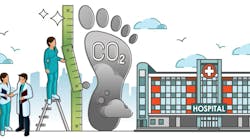In what might seem like a highly polarized world, here’s something we can all agree on: The healthcare supply chain needs to become more resilient. It’s not just a matter of avoiding administrative headaches. It’s a matter of saving lives.
That’s not hyperbole. The importance of supply chain resiliency in healthcare transcends other industries: Ensuring healthcare caregivers have the supplies they need when they need them is literally a matter of life and death. Unfortunately, the healthcare supply chain also stands apart from other industries when it comes to complexity.
In contrast to other industries, healthcare lacks a dominant customer who “sets the standard” in how resiliency, risk, and performance are managed. Ours is a highly complex system, with a vast cast of stakeholders. That’s made it difficult to pin down a common and scalable system for monitoring, reporting, and ensuring resiliency among healthcare suppliers—until now.
The Emergence of a Common Resiliency Standard
A few years ago, a cohort of trading partners—leaders on both the provider and supplier sides of the industry—started having important conversations around healthcare supply chain resiliency. They believed that resiliency could only be solved through collaboration, and they wanted to increase partnership, communication, and transparency as a foundation for resiliency. Thus, the Healthcare Industry Resilience Collaborative (HIRC) was born.
HIRC is a nonprofit trade association focused on solving for one thing: a more transparent and resilient supply chain. The shared purpose of its members, providers and suppliers alike, is to increase supply chain resiliency through alignment to standards and best practices, and to foster a culture of collaboration to increase partnership, communication, and transparency.
Since HIRC’s founding, its community has quickly grown to include a host of leading providers, suppliers, and industry partners. Now, the organization has reached a pivotal moment with the launch of the HIRC Resiliency Badging Program. If our industry is going to come together to ensure healthcare supply chain resiliency in a fair and effective way, now is the time for providers and suppliers alike to act.
A “Put Up or Shut Up” Moment for Healthcare Supply Chain Resiliency
On the heels of the pandemic, the HIRC community’s quest to address the need for greater collaboration, visibility, and resilience in healthcare has never been more important than it is today. Scalable and common systems across providers are critical to achieving the kind of broad adoption that can lead to a stronger, more resilient healthcare supply chain. Specifically, HIRC has established the Resiliency Badge as a common framework for providers to use in understanding the health and risk of their trading partners. HIRC was founded with the belief that providers and suppliers should be doing this important work together, ensuring both sides have a voice and are able to achieve their business objectives in an efficient and balanced manner. As HIRC’s slogan goes, “We are stronger together.”
One of the most important goals of the HIRC initiative—and a reason why it’s important for suppliers and providers to be getting on board right now vs. a year from now—is to prevent the market from fragmenting. Quite simply, the need to ensure resiliency within the healthcare supply chain is urgent and widely acknowledged as a current gap in the system. When gaps are clearly identified, for-profit companies race to present solutions, often creating a fragmented web of options that are adopted unevenly by healthcare providers. For suppliers, this would be a nightmare scenario, with numerous (and likely more-complicated) certifications and resiliency checklists to manage in order to continue working with their customers.
In other words, the HIRC Resiliency Badge’s value extends well beyond providers. It’s in suppliers’ best interests to make the HIRC Resiliency Badge successful. This is our opportunity as an industry—suppliers and providers together—to collectively control our future by creating a common, scalable solution.
Taking Steps Today to Ensure a Resilient Future for Healthcare
The newly launched HIRC Resiliency Badge program is now available to medical product suppliers looking to set themselves apart from competitors through their commitment to resiliency within the healthcare supply chain. To date, more than four dozen provider organizations—including Mayo Clinic, Cleveland Clinic, Northwestern, Stanford, BJC, CommonSpirit, Corewell, and others—have signed on as members of HIRC, pledging to prioritize HIRC’s standards for transparency and resiliency within their RFP processes and sourcing criteria.
The goal of the HIRC Resiliency Badge is to make resiliency a winning strategy in healthcare for suppliers. As a growing number of providers prioritize HIRC standards compliance when selecting their medical product vendors, suppliers that achieve the HIRC Resiliency Badge will establish themselves as valued and reliable partners within the highly competitive healthcare space, while also enabling efficiency by reducing one-off data requests.
The badging program creates a robust scoring rubric to evaluate and enhance supply chain resiliency within the healthcare industry. To conduct this assessment, HIRC employs various tools, including analysis of key performance indicators (KPIs), policies and procedures, survey responses, and interviews. These key data requests provide the foundation to conduct an in-depth diagnostic of an organization’s resiliency.
The HIRC Resiliency Badge benefits providers by providing confidence that badged suppliers have the capability to deliver critical products reliably. Providers also enjoy added efficiency by not having to investigate and gather resiliency data independently. From the provider standpoint, the HIRC badge can be operationalized in the following ways:
- Using the HIRC standard when evaluating suppliers vs. creating the organization’s own unique solution or requirements
- Incorporating the standard into contractual language, business reviews, and performance expectations
- Using the resiliency badge findings to foster meaningful discussions on how to improve a hospital’s end-to-end supply chain
- Including the badge in internal stakeholder engagement and supplier decision-making
This is the healthcare industry’s opportunity to collectively control its future and build a common, scalable solution. We know there is a deep need for a program like this, and providers and suppliers alike now have the opportunity to influence its shape and prevent the market from fragmenting into hundreds of for-profit solutions that create more-complicated and inconsistent expectations as they race to fill the gap. It is in suppliers’ and providers’ best interest to make the HIRC Resiliency Badge successful. If we don’t take control of our future together, someone else will.





